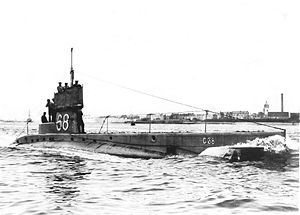|
HM Submarine C-29, lost over a mine
 Throughout the war, submarines patrolled the Heligoland Bight off the German North Sea coast as part of the Royal Navy`s blockade of the German High Seas Fleet. The lack of success in the joint action with surface forces on 28 August 1914 (the Battle of the Heligoland Bight) proved that the submarine was best used as a lone weapon. Thereafter, the rest of the war was spent in long periods of uneventful reconnaissance punctuated by attacks on German ships on the few occasions when they ventured to sea Throughout the war, submarines patrolled the Heligoland Bight off the German North Sea coast as part of the Royal Navy`s blockade of the German High Seas Fleet. The lack of success in the joint action with surface forces on 28 August 1914 (the Battle of the Heligoland Bight) proved that the submarine was best used as a lone weapon. Thereafter, the rest of the war was spent in long periods of uneventful reconnaissance punctuated by attacks on German ships on the few occasions when they ventured to sea
For a short period in 1915, when it was believed that the best anti-submarine weapon might be another submarine, four C class boats were deployed on anti-U-boat duties off Britain`s east coast, it was a common tactic for submarines to be town by trawler-acting as bait, in order to gain speed and save time and fuel. Once an enemy boat was spotted the trawler and town submarine were decupled in order for the submarine to try and hunt the enemy boat. Two U-boats were destroyed using this tactic by C-24 and C-27.
The C-29 was a C class submarine laid down by Vickers Sons & Maxim Ltd and launched on June 19, 1909.
On August 29, 1915 C-29 was involved in a U-boat hunting with a trawler. She was proceeding, dived, in the tow of the trawler Ariadne off Humber, in an area in which German submarines were very active. Those on board the Ariadne were horrified to see an explosion astern; C-29 had been towed into a mine. This marked the end of the trawler-submarine partnership.
 |
Sierra Leone |
2001 |
C class submarine, C-29 |
|